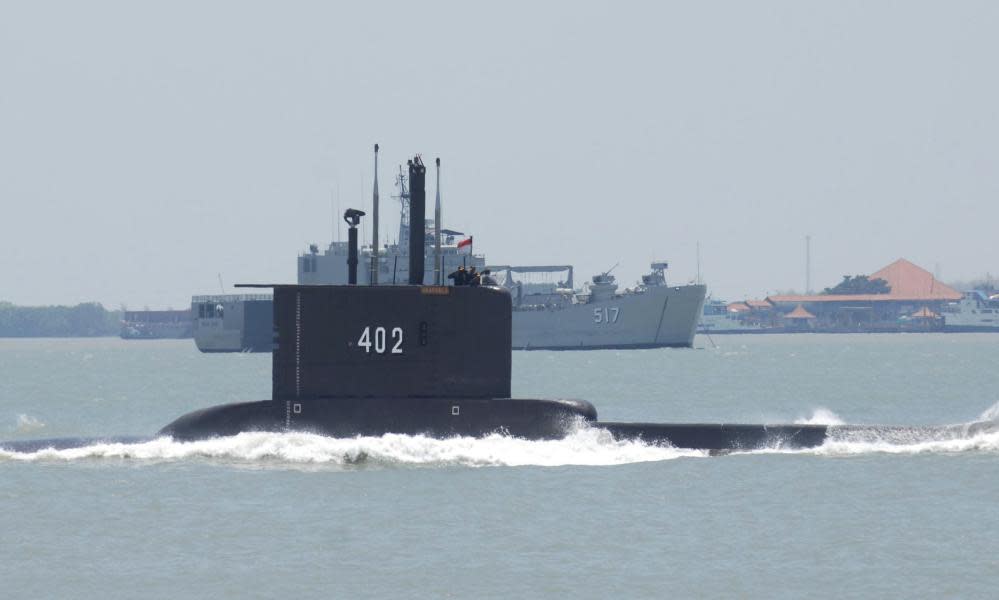Indonesia continues search for missing submarine carrying 53 people

Hope is fading for the 53 crew members on a missing Indonesian submarine, as the search for the vessel continues off the coast of Bali.
The Indonesian navy has revealed that an oil spill at sea was spotted near the early diving position of the KRI Nanggala-402 before it went missing.
Indonesia’s defence ministry said the navy lost contact with the ship soon after it was given clearance to dive, at about 3am on Wednesday.
Related: Indonesian navy submarine goes missing with 53 people onboard
Earlier, defence officials had said they believed the ship had an electrical failure during the dive, causing it to lose control and preventing it from resurfacing. They believe it may have sunk to a depth of 600 to 700 metres.
Frank Owen, a submarine rescue expert, told the Guardian that this particular vessel was only designed to dive to a depth of less than half that.
“The submarine is designed to go to about 250 metres, and they usually have probably double that as a safety margin, but when you’re starting to get below that, who knows?
“At that depth of water, they could still be in one piece, but there probably would have been lots of buckling. If something fails, then everything fails.”
Owen said there were three likely outcomes for the submarines and its crew.
“Its either on the seabed, or it’s on the surface. Or it’s just operating and it’s unaware that people are looking for it. It’s one of three options. It could be a communication failure, but it has been 24 hours since the submarine was lost, so it’s looking less and less likely.”
He said it was not likely that the submarine was still operating and had just lost communication.
“They had an exercise they were going to do, there was an expectation they were going to communicate, but they didn’t communicate. So it’s either a communication problem or a submarine problem.”
Yudo Margono, the chief of staff of the Indonesian navy, said there were two possibilities for the oil spill: a leak caused by a crack in the tank of the submarine, or the deliberate disposal of oil by the crew to try to prevent the submarine from sinking.
Margono emphasised that in a blackout situation, people on a submarine can survive for three days. “It lost contact at 3am yesterday, so there is still time until Saturday at 3am. Hopefully, it will be rescued soon, so that oxygen supply is still there,” Margono told a press conference on Thursday.
Several countries, including Australia, Singapore and India, have responded to a request for help from Indonesia to search for the missing submarine.
“We have had good cooperation with Singapore and Australia in the search and handling of training accidents,” military commander and air chief marshal Hadi Tjahjanto said.
Australia’s defence minister, Peter Dutton, said that he had called his counterpart, Prabowo Subianto, and offered Australia’s assistance.
I am very concerned by reports regarding an Indonesian submarine, KRI Nanggala, that is missing off the coast of Bali.
I have spoken to Defence Minister @prabowo today to offer Australia’s assistance.— Peter Dutton (@PeterDutton_MP) April 22, 2021
The foreign minister, Marise Payne, also said Australia would provide any assistance it could, but that submarine rescues were complex and difficult.
“It is not a submarine that Australia operates; our submarine class is quite different, but whatever we are able to do we have undertaken to do, and I think those submariners and their families are very much in need of all of our thoughts and prayers.”
The Indonesian navy has indicated it has deployed all ships equipped with underwater devices to help with the search and rescue mission.
The missing 209/1300-type submarine was built in Germany’s Howaldtswerke-Deutsche Werft in 1977, and was officially inducted into the navy in 1981, making it one of the oldest submarines still active.
James Goldrick, a retired rear admiral and naval historian, said the age of the vessel could have been a contributing factor.
“Getting to 40 years old is really starting to push it,” he said. “Almost nobody operates submarines that old. The worry here is that not only is the boat approaching 40 years old, as an original boat, but the length of time since the last major refit is approaching the limit.”
The last time KRI Nanggala was refitted was in 2012, in South Korea, where parts of its structure were replaced or upgraded.
Goldrick said rescue efforts would be extremely difficult, especially if the ship had actually sunk to the seabed.
“The problem is that if the submarine is in an area that’s too deep, there’s very little you can do about it if it has actually gone down. It’s practically impossible to get them out at that depth.
“The seabed isn’t necessarily flat, and it is quite likely to have some crevasses and some rises, so even if the submarine is still a whole hull, it may be very difficult to find. Submarining can very easily go wrong. The potential for the worst to have happened is very high.”
Goldrick said even finding the ship would be difficult, even if the oil spill spotted close to the last diving position gave some indication where it might be.
“The oil slick might give an indication, and with an understanding of the environmental conditions, the prevailing currents and the wind, you might be able to say, well you can track back to a likely position, but it’s very difficult.
“So you have an area of probability that you need to search in, and even in very deep water, a small area of possibility can be very difficult.

 Yahoo Movies
Yahoo Movies 
